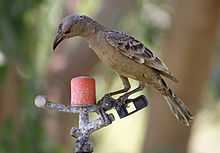Great Bowerbird
| Great Bowerbird | |
|---|---|
 | |
| Conservation status | |
| Scientific classification | |
| Kingdom: | Animalia |
| Phylum: | Chordata |
| Class: | Aves |
| Order: | Passeriformes |
| Family: | Ptilonorhynchidae |
| Genus: | Chlamydera |
| Species: | C. nuchalis |
| Binomial name | |
| Chlamydera nuchalis Jardine & Selby, 1830 | |



The Great Bowerbird (Chlamydera nuchalis) is a common and conspicuous resident of northern Australia, from the area around Broome across the Top End to Cape York Peninsula and as far south as Mount Isa. Favoured habitat is a broad range of forest and woodland, and the margins of vine forests, monsoon forest, and mangrove swamps.
As with most members of the bowerbird family, breeding considerations dominate the lifecycle: females nest inconspicuously and raise their young alone, while the males spend most of the year building, maintaining, improving, defending, and above all displaying from their bowers. Only a male with a successful bower can attract mates.
The Great Bowerbird is the largest of the bowerbird family and is 33 to 38 cm long and fawny grey in colour. Males have a small but conspicuous pink crest on the nape of the neck.
The Bower
The male builds the largest bower of all bowerbirds. It is a twin-walled avenue-type bower approximately 1 metre long and 45 cm high. It is typically located under a shrub or leafy branch. The ends of the bower are scattered with white and green objects - stones, bones, shells and leaves and small man-made objects such as plastic and bottle caps. Within the bower itself is sometimes placed clear glass.
Uniquely among bowerbirds, groups of young males will attend a single bower concurrently, "practising" their bower-building skills prior to establishing their own bower for mating purposes.
References
- ↑ Título não preenchido, favor adicionar. Agenciabrasil.ebc.com.br.
- ↑ Título não preenchido, favor adicionar. Folha.com.
- ↑ Título não preenchido, favor adicionar. Economia.ig.com.br.
- ↑ Título não preenchido, favor adicionar. Coficpolo.com.br.
- ↑ BirdLife International (2012). "Chlamydera nuchalis". IUCN Red List of Threatened Species. Version 2013.2. International Union for Conservation of Nature. Retrieved 26 November 2013.
External links
| |||||||||||||||||||||||||||||||||||||
